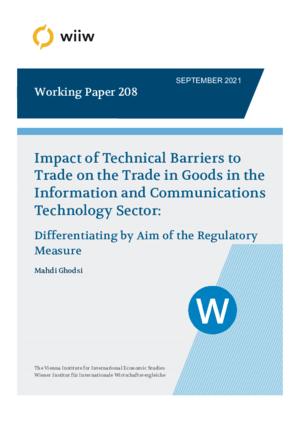Impact of Technical Barriers to Trade on the Trade in Goods in the Information and Communications Technology Sector: Differentiating by Aim of the Regulatory Measure
wiiw Working Paper No. 208, September 2021
42 pages including 5 Tables and 18 Figures
In this modern digital world, goods from the information and communications technology (ICT) sector are the engine of the global economy. While tariffs levied on ICT goods have been eliminated or significantly reduced since the conclusion in December 1996 of the Information Technology Agreement of the World Trade Organization (WTO), non-tariff measure (NTMs) have come to be used more frequently with regard to imports of these goods. Technical barriers to trade (TBTs), as the most important trade policy measure imposed on imports of ICT goods, form the focus of this study. This paper analyses how different types of TBTs imposed on imports of ICT goods globally affected the values and volumes of imported goods at the six-digit level of the Harmonised System (HS) during the period 1996-2018. Keywords cited in the TBTs notified to the WTO give an indication of the aims behind the imposition of TBTs. Therefore, this study digs deeper into the impact of 30 types of TBT, using the keywords cited. The methodology used in this paper controls for zero trade flows using the Pseudo Poisson Maximum Likelihood (PPML) technique; and it controls for endogeneity bias using the exogenous instrumental variable approach. Furthermore, the paper provides more detailed analysis of the impact of TBTs across five ICT product categories that are defined by the United Nations Conference on Trade and Development (UNCTAD). The results indicate that TBTs have a generally strong positive impact on the value of imports of ICT goods. While many keywords cited in TBTs notified to the WTO affect the values and volumes of imports in a positive way, certain other TBTs function as trade barriers that reduce their values and volumes.
Keywords: Information and communications technology, non-tariff measures, technical barrier to trade, World Trade Organization, Pseudo Poisson Maximum Likelihood
JEL classification: F13, F14, L15
Countries covered: non specific
Research Areas: International Trade, Competitiveness and FDI
